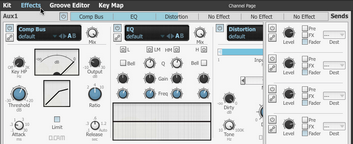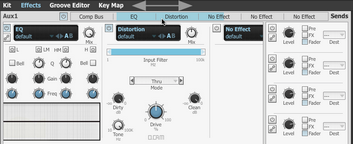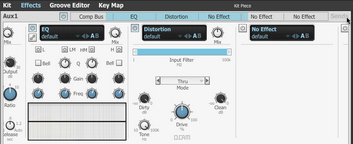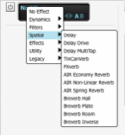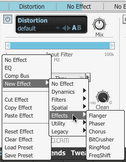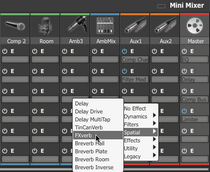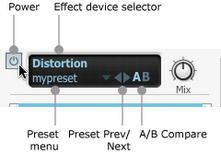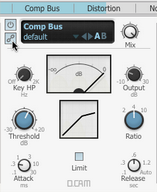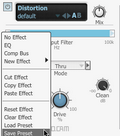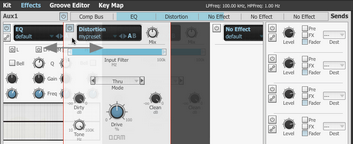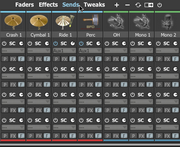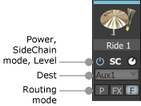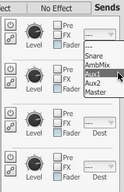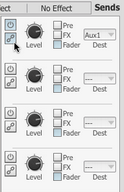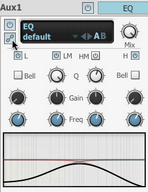|
The Effects Editor allows full control over the currently selected channel's 6 insert effect slots and its 4 Sends. This panel and the Kit display cannot be viewed simultaneously. Click the Effects button to show the Effects Editor in place of the Kit display. |
Overview
|
The Effects rack Effects are BFD3's built-in DSP audio processors. The Effects rack shows the contents of the 6 effect slots on the currently selected mixer channel. Effect slots Each of the 6 available effect slots can host any of the internal BFD3 DSP effect devices. |
Effect scroller
The Effect scroller is a representation of the selected channel's 6 available effect slots, with the highlighted area indicating which slots are currently visible. The size of the visible area depends upon the current width setting of the BFD3 window.
To change the visible area, click and drag the highlighted area or simply click the part of the scroller representing the desired effect slots.
Sends
The Send controls represent the 4 Send routings available from the selected mixer channel, usually to destination Aux channels, allowing you to set up parallel processing routings suitable for reverbs and parallel compression: like any other mixer channel, destination Aux channels feature 6 effect slots for these purposes.
|
Sends can also be routed to other channels for SideChain processing purposes. Click the Sends button at the top-right of the Effects Editor panel to show the Send controls if they are not currently visible. Click the Sends button again to hide the controls. Sends are discussed later in this section. |
Initializing and using Effects
Initializing an effect device within a channel's effect slot
There are 3 ways to load a device into an effect slot:
Effect slot's Effect device selector
|
Each of the 6 effect slots for a channel features a main header section which features an Effect device selector drop-down menu with a number of other controls. Firstly, select the desired channel in the mixer by clicking it. Then, display the Effects Editor by clicking the Effects button in BFD3's main navigation bar. Click the part of the desired effect slot header that shows No Effect - if the slot is empty - or the name of the effect already loaded into the slot. This displays a menu of available effects arranged within sub-menus according to effect type. Navigate to the desired effect device and click it to load it into the slot. The previous contents of the effect slot are discarded. |
Effect context menu
|
Display the Effects Editor for a mixer channel as described above. Right-click on any effect slot to display the effect context menu. The Effect device selector menu is located within the New Effect sub-menu, again providing all available effects arranged within sub-menus according to effect type. Navigate to the desired effect device and click it to load it into the slot. The previous contents of the effect slot are discarded. |
Effects channel mode in the mixer
|
Switching the mixer to Effects channel mode (with the Effects channel mode switch) shows basic controls for all channels' 6 effect slots simultaneously. The Effect device selector allows you to load an effect device into each slot. Each slot's Power button is also available, as is an Edit button to quickly switch to viewing the effect in the Channel Editor if it is not already visible. |
Main effect slot controls
All effect slots share the following common controls on their interfaces:
|
The Power button enables or disables the effect device loaded into the slot. With the button deactivated, the device is disabled and bypassed. This control is also available in the mixer's Effects channel mode. You can also turn all currently loaded effect devices on and off using the main Effect Power button above the mixer.
|
Effect device selector
This drop-down menu provides a menu of available effects. Click any effect in the menu to load it into the slot and replace its previous contents.
Preset menu
The Preset menu features a drop-down menu showing all available presets for the effect device in the slot.
Preset Prev / Next
The Preset Prev / Next cycle through the effect's available presets.
A/B Compare
These buttons toggle between two distinct states for the effect, each with its own settings and preset-loading.
By default, the 'A state' is in operation and highlighted in blue. To try completely different settings without having to save the current settings as a preset first, click the B button - this switches to the 'B state' and all further adjustments are now made to the B state. Presets can be loaded and any effect settings can be changed as desired.
To return to the A state, click the A button again - the original settings reappear. Of course, any adjustments previously made to the B state are recalled should you decide to return to it by clicking the B button again.
Mix
The Mix control, which allows blending between the processed (wet) and unprocessed (dry) signals, exists on all BFD3 effect devices.
Note that this control only appears when an effect device is loaded into the slot.
By default, all effects are set to 100% wet, but this control allows you to adjust this as required.
This control is useful on compressor devices for creating parallel compression effects for a single channel without needing to set up an additional aux channel.
|
SideChain mode The SideChain mode button is only available on certain SideChain-enabled effects when used on on Aux channels and the Master channel. When the button is activated on the Comp Bus as in this example, the effect uses the SideChain input for driving the peak detection circuit, meaning that the amplitude characteristics of a separate signal are used to treat the amplitude of the actual signal entering the compressor's main input. When the EQ or EQ8 devices are used, activating the SideChain mode button results in the device processing the SideChain signal before it reaches a SideChain-enabled effect further on in the channel's signal path. This function is provided for situations when greater tonal control of the SideChain input signal is required than that offered by the Key HP control on the Comp Bus effect, for example. |
BFD3's SideChain features are discussed in more detail later in this chapter.
Managing Effects with the Effect context menu
Right-click on an effect interface to display the effect context menu.
|
EQ / Comp Bus These items represent shortcuts for loading the EQ or Bus Compressor into the effect slot, as these are likely to be the most commonly used processors in a mix.
New effect This sub-menu performs the same function as the slot's Effect device selector - it provides a menu of available effects. Click any effect in the menu to load it into the slot and replace its previous contents. |
Cut / Copy / Paste Effect
These functions allow you to cut/copy/paste effect devices between effect slots and mixer channels.
Reset effect
This function resets the current effect to its default settings.
Clear effect
This function removes the effect from the slot.
Load preset
Clicking this item displays a system file open dialog which allows you to load previously saved preset files for the effect.
You can also use the Preset selector in order to quickly browse through available presets saved in the default preset folder for the effect.
Save preset
Clicking this item brings up a system file save dialog, allowing you to save the effect’s current settings as a preset - it is recommended to use the default location so that presets become available on the effect's Preset menu.
Swapping and copying effect devices between slots using drag and drop
Effects can be re-ordered and copied between a channel's effect slots using drag and drop. This offers a quicker way of performing these tasks compared to using the Copy/Paste and Clear functions on the effect context menu.
|
Swapping effects between slots Simply click an effect device's interface, drag it to the left or right and drop it into another slot. Any effect device already loaded within the destination is swapped into the original slot that was moved over it.
|
Copying an effect from one slot to another
Hold down the ALT key while performing a drag and drop operation as described above to copy the original effect onto the destination slot.
Any effect device previously in the destination slot is discarded.
Using Sends and Sidechains
4 Sends are available per channel for parallel processing and sidechaining purposes. Sends can be routed to any available Aux channel as long as the destination channel is to the right of the source channel. They can also be routed to the Master channel and other channels such as Drum and Ambient Mix channels (these are effectively Aux channels with Drum sub-mic or Ambient mic channels' outputs routed to them) for sidechain applications.
Sends can be routed into the main input or to the sidechain input of the destination channel. Sidechaining is used for certain effects which allow you to process the main input while reacting to properties of the sidechain input signal.
Displaying Send controls
Controls for Sends can be displayed in 2 ways:
|
|
Sends panel in Effects Editor Firstly, select the desired channel in the mixer by clicking it. Then, display the Effects Editor by clicking the Effects button in BFD3's main navigation bar. If the Sends panel is not currently displayed within the Effects Editor, click the Sends button to make it visible. |
Sends channel mode in the mixer Switching the mixer to Sends channel mode shows smaller versions of the Send controls for all channels simultaneously. |
Send controls
The following controls are available for all 4 Sends from the currently selected channel, and can be accessed using the Sends panel in the Effects Editor or using the Sends channel mode in the mixer.
|
Power The Power button activates or deactivates the Send. This button is activated automatically when the Dest control is used to set a Send destination. Dest (Destination) The Send destination is selected using the Dest drop-down menu. Level This control sets the Send level - the amount of the signal that is sent to the destination. |
|
Routing mode Using this set of buttons, each Send can be routed from any of 3 source points in the channel signal path: Pre (Pre FX, pre-fader) The Send signal is tapped before the channel's effect slots. This point is also pre-fader. Therefore, the signal reaches the Send destination without being processed by the channel's effects, and is not affected by any level adjustment via the channel's level fader. |
FX (Post-FX, pre-fader)
The Send signal is tapped after the channel's effects but before the fader. Therefore, the signal reaches the Send destination after being processed by the channel's effects, but is not affected by any level adjustment via the channel's level fader.
Fader (Post-fader)
The Send signal is tapped after the channel's level fader. Therefore, the signal reaches the Send destination after being processed by the entire channel including its effect slots and level fader.
This is the default setting for the Routing mode parameter.
Sidechain mode
The send signal can be routed to either the main input for the destination channel or, with the SideChain mode button activated, to its SideChain input.
If the signal is sent to the SideChain input, the signal is not processed through the channel and its effects, but instead is used for sidechain-enabled effects with their SideChain mode button enabled. There is one exception - the EQ is capable of processing a channel's SideChain signal for reasons which are discussed in the 'Using sidechaining' section below.
Using Sidechaining
Sidechaining is the use of one signal to control the behaviour of a processor that acts on another signal. Generally, the amplitude of the sidechained signal is used to determine the dynamic output of the processed signal and it is not directly heard in the output of the processor at all. It is a common feature in compressors, in order to compress one signal according to the amplitude of another for a variety of dynamic effects.
In BFD3, any mixer channel can be used as a SideChain source for a compressor or gate inserted on an Aux channel or the Master channel.
In addition, the SideChain can also be used as the FM source when the filter FM function is used in the Filter Mod device.
Setting up sidechains
|
|
|
To set up a channel as a SideChain source for a compressor on another channel, first set up a Send to a destination channel with the compressor, and turn up the level of the Send. |
Then, click the Sidechain button for the Send source setting in the Sends panel. This Send is now routed to the SideChain input of the destination channel. |
Click the SideChain mode button on a compressor loaded into a slot on the destination channel. It now reacts to the SideChain signal with the resulting gain reduction applied to the main input signal. |
EQ-ing the sidechain
|
A common problem when compressing is the existence of excessive low-end frequencies in a sidechain signal causing a compressor to react more than desired. BFD3's compressors include a high-pass filter to quickly filter out the low end from the signal used by the peak detection process. However, you may need to apply a more complex EQ process to a SideChain signal in order to isolate a particular band of frequencies such as the mid 'crack' of a snare sound. In such cases, proceed as described above, but insert an EQ on the destination channel, ensuring that it is inserted before the compressor. Now, click the SC button on the EQ's interface: the channel's SideChain input signal is processed by the EQ rather than the channel's main input signal. The processed SideChain signal is then used by the compressor as the source for its peak detection circuit (after the compressor's SC button has also been enabled). |
